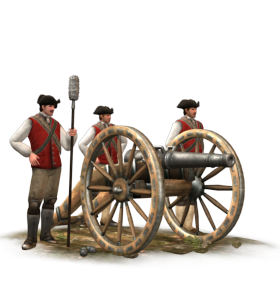Difference between revisions of "12-lber Foot Artillery (ETW Unit)"
(→Factions) |
Tango12345 (talk | contribs) m (updating category) |
||
| Line 10: | Line 10: | ||
*[[Great Britain (ETW Faction)|Great Britain]] | *[[Great Britain (ETW Faction)|Great Britain]] | ||
*[[United Provinces (ETW Faction)|United Provinces]] | *[[United Provinces (ETW Faction)|United Provinces]] | ||
| − | [[Category:Artillery]] | + | |
| + | [[Category:Empire Total War Units]] | ||
| + | [[Category:ETW Artillery]] | ||
Revision as of 06:06, 14 July 2011
Overview
Despite the name, foot artillery batteries are towed by horses, not men. The artillerymen march alongside their pieces. All guns are smooth-bore, and rated by the size or weight of solid projectile that they fire: a 12-pounder is so called because it hurls a cannonball weighing 12 pounds towards the enemy! It may not do so very accurately, as the casting of barrels and balls means that there is inevitably a gap (wind-age) between a shot and the barrel sides. This means that a cannonball rattles down the barrel when fired, leading to an inherent inaccuracy. As technology advances, other types of ammunition can be fired.
Historically, there was limited standardization between guns, even in the same battery. Parts from one gun would not always fit a sister piece. A gunner would know the quirks of his own weapon intimately. Cunningly, the French attempted to develop a system of interchangeable components for all their guns and field equipment. Jean Baptiste Vaquette de Gribeauval (1715-1789), the inspector of artillery, tried but he wasn’t entirely successful. Even after he had finished there were still more than 20 different types of wheel in use!
